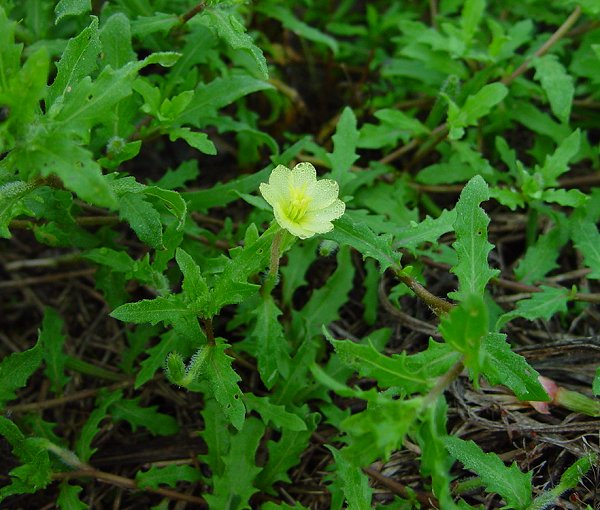Oenothera laciniata Hill
Cut-Leaved Evening Primrose

Native
CC = 1
CW = 3
MOC = 71
© DETenaglia
Oenothera laciniata HillCut-Leaved Evening Primrose | |
 |
Native CC = 1 CW = 3 MOC = 71 |
© DETenaglia |
|
Family - Onagraceae Habit - Taprooted annual or short-lived perennial. Stems - Spreading to erect, to 50 cm, single or multiple, unbranched or branched, sparsely to moderately pubescent with short, appressed, nonglandular hairs and usually also with longer, spreading nonglandular hairs, often reddish, sometimes also with minute glandular hairs toward the tip.
Leaves - Basal and alternate, the rosette leaves sometimes absent at flowering, 4-15 cm long, 10-30 mm wide, the blade narrowly oblanceolate to nearly linear, tapered to the usually long petiole, the margins usually coarsely toothed to deeply pinnately lobed, the surfaces and margins sparsely to densely pubescent with short, more or less appressed, nonglandular hairs and often also with longer, more or less spreading hairs, sometimes also with minute glandular hairs; stem leaves 2-10 cm long, 5-35 mm wide, narrowly oblanceolate to oblanceolate or narrowly oblong to narrowly elliptic, tapered to the sessile or short-petiolate base, otherwise similar to the basal leaves, the secondary veins relatively inconspicuous.
Inflorescences - Appearing as solitary, axillary flowers toward the stem tips, with buds adjacent to the most mature one curved upward by the floral tube, the subtending leaflike bracts persistent, 20-70 mm long, narrowly oblong to narrowly ovate, otherwise similar to the basal leaves. Flowers - Actinomorphic, opening at dusk, the floral tube 12-35 mm long, sparsely to densely pubescent with short, more or less straight, spreading, nonglandular hairs and minute glandular hairs, sometimes also with more or less appressed, nonglandular hairs. Sepals 5-15 mm long, the midribs not keeled, with pubescence similar to the floral tube, the free tips in bud 0.3-3.0 mm long, terminal, usually more or less spreading. Petals 4, 5-20 mm long, 7-20 mm wide, very broadly obovate, truncate to shallowly and broadly notched at the tip, lacking a stalklike base, pale yellow to yellow, fading pale orange to red. Stamens 8, with the filaments 3-14 mm long, glabrous at the base, the anthers 2-6 mm long, yellow. Style 20-50 mm long, the stigma positioned at about the same level as the anthers, deeply 4-lobed, the lobes 2.5-5.0 mm long. Ovary cylindric, villous and with short antrorse puberulent hairs, 1.2 cm long, quickly expanding in fruit, green, 8-ribbed, with many ovules.
Fruit - Capsules 20-50 mm long, 2-4 mm wide, cylindric, straight to somewhat curved, longitudinally dehiscent nearly the entire length, 4-locular, roughly circular in cross-section, the surface dull green, moderately to densely pubescent with short, appressed, nonglandular hairs and scattered, longer, more or less spreading, nonglandular hairs. Seeds numerous in each locule, arranged in 2 rows, 0.9-1.8 mm long, 0.4-0.9 mm wide, broadly ellipsoid to subglobose, the surface brown to dark brown, pitted. Self-compatible.
Flowering - May - October. Habitat - Glades, prairies, streambanks, pond margins, pastures, fields, crop fields, gardens, railroads, roadsides, and open disturbed areas. Origin - Native to the U.S. Lookalikes - Distantly, other species of Oenothera. Other info. - This species can be found throughout most of Missouri, as well as most of the eastern 2/3 of the continental U.S. The plant is low growing and easy to ID in the field because of its toothed leaves and pale yellow flowers. The flowers of this species open at night and close during sunny days. Although typically hairy as mentioned above, this species can sometimes be nearly glabrous. Photographs taken in Gainesville, FL., 6-19-02 (DETenaglia); also at St. Joe State Park, St. Francois County, MO, 5-17-2018 (SRTurner). |